Wild leafy greens are eaten throughout the year in Greece. They are very popular during fasting periods. Here's an article I originally published through Suite101.
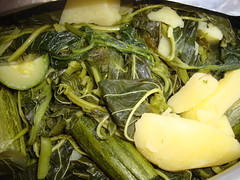 Horta have always been a significant part of Greek cuisine and continue to be a popular choice for a meal both in the Greek taverna and with the home cook. Amongst the wide range of vegetarian dishes in Greek cuisine, there is a particular group known as 'horta', from the Greek word χoρτα, meaning 'grass'. Both wild and domesticated leafy greens form an integral part of a Greek island taverna meal, found under the 'salads' label on the menu card. Horta were one of the staple survival foods in many parts of Greece in the years of famine during the Nazi occupation of the country in WW2.
Horta have always been a significant part of Greek cuisine and continue to be a popular choice for a meal both in the Greek taverna and with the home cook. Amongst the wide range of vegetarian dishes in Greek cuisine, there is a particular group known as 'horta', from the Greek word χoρτα, meaning 'grass'. Both wild and domesticated leafy greens form an integral part of a Greek island taverna meal, found under the 'salads' label on the menu card. Horta were one of the staple survival foods in many parts of Greece in the years of famine during the Nazi occupation of the country in WW2.
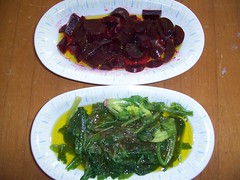 Horta constitute both a side dish and a main meal
Horta have always formed an integral part of the range of traditional Greek foods, and are fundamental to the Mediterranean diet whose origin lies in Crete. When a Greek cook prepares a meal of horta at home, they actually form the main part of a meal, not just an accompaniment to a meal, unlike when eating out at a Greek taverna, when horta will more likely be a side dish to other main course.
Horta constitute both a side dish and a main meal
Horta have always formed an integral part of the range of traditional Greek foods, and are fundamental to the Mediterranean diet whose origin lies in Crete. When a Greek cook prepares a meal of horta at home, they actually form the main part of a meal, not just an accompaniment to a meal, unlike when eating out at a Greek taverna, when horta will more likely be a side dish to other main course.
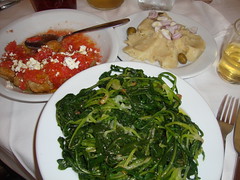 When the home cook prepares horta for the main meal of the day, they will be boiled and served together with maybe some beans or zucchini, according to the season, all dressed in olive oil and lemon juice. Carbohydrates in the form of boiled potatoes accompany these leafy vegetables as a side dish, along with some cheese, a boiled egg, or maybe some small fish like sardines for protein.
When the home cook prepares horta for the main meal of the day, they will be boiled and served together with maybe some beans or zucchini, according to the season, all dressed in olive oil and lemon juice. Carbohydrates in the form of boiled potatoes accompany these leafy vegetables as a side dish, along with some cheese, a boiled egg, or maybe some small fish like sardines for protein.
Bread is essential with horta to mop up the remaining olive oil on the plate. Taken altogether, this combination of very simple foods forms a very balanced diet, which makes it easier to understand how the Greek people survived during harsher times when food was scarce.
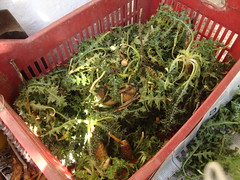 Different varieties of horta for different seasons
The temperate Greek climate allows horta to grow abundantly all over Greece. Apart from being grown in cultivated fields, they are also foraged in wild pasture lands. They are sold at street markets, in greengrocers, and in the supermarket. The variety of Greek horta differs according to the season, because different horta are available at different times of the year. A variety of amaranth, called vlita in Greek, grows from late spring to late summer.
Different varieties of horta for different seasons
The temperate Greek climate allows horta to grow abundantly all over Greece. Apart from being grown in cultivated fields, they are also foraged in wild pasture lands. They are sold at street markets, in greengrocers, and in the supermarket. The variety of Greek horta differs according to the season, because different horta are available at different times of the year. A variety of amaranth, called vlita in Greek, grows from late spring to late summer.
In Cretan cuisine, a highly prized variety of horta of the Chicorium species, stamnagathi, used to be foraged only in the wild in the cooler seasons, but is now being cultivated successfully throughout the year. Although most leafy greens have now been domesticated, there are still some that are only found in the wild, like the ascrolimbus plant used in Cretan cuisine, with its thorny leaves and edible roots. Radiki (from both Taraxacum and Chicorium species) is also very popular. An added bonus of horta is that when they are foraged in the wild, they're often organic. They are harvested by rural experts who are able to distinguish between the varieties and know which ones are edible or not.
 Horta have always been a significant part of Greek cuisine and continue to be a popular choice for a meal both in the Greek taverna and with the home cook. Amongst the wide range of vegetarian dishes in Greek cuisine, there is a particular group known as 'horta', from the Greek word χoρτα, meaning 'grass'. Both wild and domesticated leafy greens form an integral part of a Greek island taverna meal, found under the 'salads' label on the menu card. Horta were one of the staple survival foods in many parts of Greece in the years of famine during the Nazi occupation of the country in WW2.
Horta have always been a significant part of Greek cuisine and continue to be a popular choice for a meal both in the Greek taverna and with the home cook. Amongst the wide range of vegetarian dishes in Greek cuisine, there is a particular group known as 'horta', from the Greek word χoρτα, meaning 'grass'. Both wild and domesticated leafy greens form an integral part of a Greek island taverna meal, found under the 'salads' label on the menu card. Horta were one of the staple survival foods in many parts of Greece in the years of famine during the Nazi occupation of the country in WW2.  Horta constitute both a side dish and a main meal
Horta have always formed an integral part of the range of traditional Greek foods, and are fundamental to the Mediterranean diet whose origin lies in Crete. When a Greek cook prepares a meal of horta at home, they actually form the main part of a meal, not just an accompaniment to a meal, unlike when eating out at a Greek taverna, when horta will more likely be a side dish to other main course.
Horta constitute both a side dish and a main meal
Horta have always formed an integral part of the range of traditional Greek foods, and are fundamental to the Mediterranean diet whose origin lies in Crete. When a Greek cook prepares a meal of horta at home, they actually form the main part of a meal, not just an accompaniment to a meal, unlike when eating out at a Greek taverna, when horta will more likely be a side dish to other main course.How are horta served at the Greek table?
 When the home cook prepares horta for the main meal of the day, they will be boiled and served together with maybe some beans or zucchini, according to the season, all dressed in olive oil and lemon juice. Carbohydrates in the form of boiled potatoes accompany these leafy vegetables as a side dish, along with some cheese, a boiled egg, or maybe some small fish like sardines for protein.
When the home cook prepares horta for the main meal of the day, they will be boiled and served together with maybe some beans or zucchini, according to the season, all dressed in olive oil and lemon juice. Carbohydrates in the form of boiled potatoes accompany these leafy vegetables as a side dish, along with some cheese, a boiled egg, or maybe some small fish like sardines for protein.Bread is essential with horta to mop up the remaining olive oil on the plate. Taken altogether, this combination of very simple foods forms a very balanced diet, which makes it easier to understand how the Greek people survived during harsher times when food was scarce.
 Different varieties of horta for different seasons
The temperate Greek climate allows horta to grow abundantly all over Greece. Apart from being grown in cultivated fields, they are also foraged in wild pasture lands. They are sold at street markets, in greengrocers, and in the supermarket. The variety of Greek horta differs according to the season, because different horta are available at different times of the year. A variety of amaranth, called vlita in Greek, grows from late spring to late summer.
Different varieties of horta for different seasons
The temperate Greek climate allows horta to grow abundantly all over Greece. Apart from being grown in cultivated fields, they are also foraged in wild pasture lands. They are sold at street markets, in greengrocers, and in the supermarket. The variety of Greek horta differs according to the season, because different horta are available at different times of the year. A variety of amaranth, called vlita in Greek, grows from late spring to late summer.In Cretan cuisine, a highly prized variety of horta of the Chicorium species, stamnagathi, used to be foraged only in the wild in the cooler seasons, but is now being cultivated successfully throughout the year. Although most leafy greens have now been domesticated, there are still some that are only found in the wild, like the ascrolimbus plant used in Cretan cuisine, with its thorny leaves and edible roots. Radiki (from both Taraxacum and Chicorium species) is also very popular. An added bonus of horta is that when they are foraged in the wild, they're often organic. They are harvested by rural experts who are able to distinguish between the varieties and know which ones are edible or not.
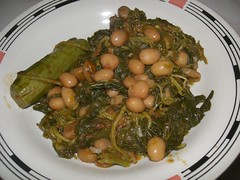
this is a great article..i love horta so much but it's hard to find many of the greens in australia..i let certain 'weeds' such as stinging nettles and dandelion grow in my garden but so far i haven't grown vlita..i'm determined to find some seeds so that i can use it make delicious horta salads..
ReplyDelete